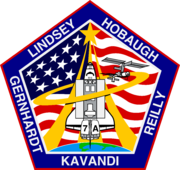 Quest being grappled by Canadarm2, prior to its installation on the ISS | |
| Names | Space Transportation System-104 |
|---|---|
| Mission type | ISS assembly |
| Operator | NASA |
| COSPAR ID | 2001-028A |
| SATCAT no. | 26862 |
| Mission duration | 12 days, 18 hours, 36 minutes, 39 seconds |
| Distance travelled | 8,500,000 kilometres (5,300,000 mi) |
| Orbits completed | 200 |
| Spacecraft properties | |
| Spacecraft | Space Shuttle Atlantis |
| Launch mass | 117,129 kilograms (258,225 lb) |
| Landing mass | 94,009 kilograms (207,254 lb) |
| Payload mass | 8,241 kilograms (18,168 lb) |
| Crew | |
| Crew size | 5 |
| Members | |
| EVAs | 3 |
| EVA duration | 16 hours, 30 minutes |
| Start of mission | |
| Launch date | 12 July 2001, 09:04 UTC |
| Launch site | Kennedy, LC-39B |
| End of mission | |
| Landing date | 25 July 2001, 03:38 UTC |
| Landing site | Kennedy, SLF Runway 15 |
| Orbital parameters | |
| Reference system | Geocentric |
| Regime | Low Earth |
| Perigee altitude | 372 kilometres (231 mi) |
| Apogee altitude | 390 kilometres (240 mi) |
| Inclination | 51.6 degrees |
| Period | 92.2 minutes |
| Docking with ISS | |
| Docking port | PMA-2 (Destiny forward) |
| Docking date | 14 July 2001 03:08 UTC |
| Undocking date | 22 July 2001 04:54 UTC |
| Time docked | 8 days, 1 hour, 46 minutes |
  Left to right: Seated - Charles O. Hobaugh, Steven W. Lindsey; Standing - Michael L. Gernhardt, Janet L. Kavandi, James F. Reilly | |
STS-104 was a Space Shuttle mission to the International Space Station (ISS) flown by Space Shuttle Atlantis. Its primary objectives were to install the Quest Joint Airlock and help perform maintenance on the International Space Station. It launched on 12 July 2001 at 09:04 UTC, and returned to Earth without incident after successful docking, equipment installation, and three spacewalks.




